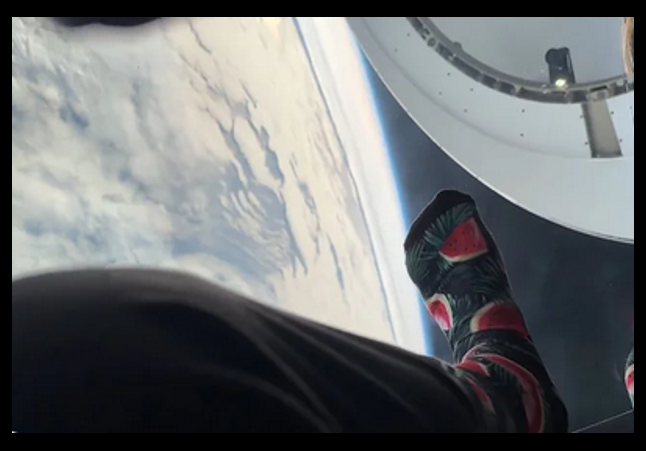SpaceX Fram2 Private Mission Successfully Concludes Historic Orbit around Earth’s Poles
Fram2 is SpaceX’s 17th human spaceflight overall, its sixth for private customers.

The Fram2 mission, SpaceX’s latest private spaceflight, concluded after a historic splashdown in the Pacific Ocean near Oceanside, California. This marked the first time a SpaceX crewed mission returned to Earth via the West Coast, as all previous missions had landed off Florida’s coast.
This mission also achieved another historic milestone: it was the first human spaceflight to circle the planet via a polar orbit.
The Fram2 mission had circled the Earth for four days in a north-south orbit. The journey was the first time people have been able to look down directly at the North and South Poles from orbit.
SpaceX moved its operations to the Pacific to eliminate the problem of Dragon debris falling in random parts of Earth. The Pacific is the biggest pool of water on the planet, and the weather along the West Coast of the United States tends to be pretty nice, too, which provides more days favorable for the return of astronauts.
The Fram2 mission was a free-flight endeavor, meaning the spacecraft did not dock with any orbital facility, such as the International Space Station. During their three-and-a-half days in space, the crew conducted 22 scientific experiments, including capturing auroras, growing mushrooms in microgravity, and taking the first X-ray of a human in space.
The crew had an international mix of talent.
Maltese cryptocurrency billionaire Chun Wang funded Fram2, and served as mission commander during his crew’s training and spaceflight. Chun is joined by fellow polar explorers Jannicke Mikkelsen of Norway, as designated Dragon commander; Rabea Rogge, from Germany, as mission pilot; and Australian Eric Philips as mission specialist and medical officer.
“Framonauts” also took the opportunity to capture stunning images of the Earth’s poles.
The first footage of the poles from Fram2.
We are the first humans to ever see this.
— A. Pettit (@PettitFrontier) April 1, 2025
In addition to enjoying the novel views, the crew focused on research and celebrated the fact they were on the sixth private SpaceX mission. SpaceX also hit another historic first with this expedition by having the fewest days between astronaut launches.
Fram2 is named after the late 19th century Norwegian seafaring ship “Fram,” which explored the Arctic and Antarctic regions at the turn of the 20th century. (“Fram” is Norwegian for “forward” or “onward.”)
Fram2 carries on the exploration spirit of its ocean-going predecessor. It carries a total of 22 experiments the crew will conduct during the mission, including the first attempt to grow mushrooms in space and a machine that will capture the first on-orbit X-rays of the human body. Other experiments will investigate the effects of microgravity on the human musculoskeletal system during spaceflight.
Fram2 is SpaceX’s 17th human spaceflight overall, and the sixth launched for private customers. Resilience has now flown four of those; the capsule also conducted Crew-1, SpaceX first operational astronaut mission to the International Space Station (ISS) for NASA, as well as Inspiration4 and Polaris Dawn, the company’s first and most recent private crew launches to Earth orbit, respectively.
The Fram2 launch came two weeks and three days after the liftoff of SpaceX’s Crew-10 mission to the ISS for NASA — the shortest time to date between SpaceX astronaut launches.
NEW: Humans are orbiting over the North and South poles for the first time in history after being launched into space by SpaceX.
So cool.
The 'Fram2' mission lifted off from Florida on Monday & is funded by cryptocurrency investor and entrepreneur Chun Wang.
There are a total… pic.twitter.com/px4kibRfE1
— Collin Rugg (@CollinRugg) April 2, 2025
There were logistical reasons for previous missions not attempting a polar orbit. But the success of this mission shows that challenges can be overcome, and the privatization of space exploration is continuing apace.
One of the 22 life-science-focused experiments carried onboard Fram2 demanded that it reach polar orbit, which hadn’t been attempted in previous crewed missions because of the increased amount of fuel required to get there. (Fram2 flew southward from its launch site, whereas most space missions have targeted more equatorial orbits and have launched toward the east to receive a fuel-saving boost from Earth’s rotation).
Simply put, aside from the desire for some novel gimmick, there was no clear rationale for SpaceX’s mission planners or Fram2’s leader, cryptocurrency billionaire Chun Wang, to have chosen a polar orbit in the first place.
Why This MattersNone of this means that sending humans into that orbit isn’t a legitimately impressive feat. It is—all the more so because SpaceX’s Falcon 9 rocket not only safely delivered the Crew Dragon to polar orbit; it also had enough leftover fuel to still perform a pinpoint soft landing on an awaiting barge in the Atlantic Ocean.
But Fram2’s “polarity” overshadows the more mundane but no less astonishing “new normal,” in which private human spaceflight has rapidly shifted from the stuff of science fiction to a decidedly unexceptional reality.
 DONATE
DONATE
Donations tax deductible
to the full extent allowed by law.









Comments
Well done SpaceX. Meanwhile NASA still wallows in its DEI garbage.
All of this done by a company conceived and built by an African American.
And a lot of government subsidies
With an impressive return on investment!
.
I’d rather subsidize a private company that delivers than a bloated public government organization that can;t get out of it;s own way,
Nowhere near as many as NASA gets, for much less.
NASA after all is 100% government subsidized.
And here I thought maybe they were using Fram filters on their Space Capsule
Pffffffft SpaceX is not abandoning their Starbase launch sight at Boca Chica, Texas. Expect even more RUD over the Gulf of America in the coming months.
” the crew conducted 22 scientific experiments, including capturing auroras, growing mushrooms in microgravity, and taking the first X-ray of a human.”
That last claim struck me as having to be obviously false… plus, it linked to a huge article with no mention of “ray” anywhere.
Now I see it’s really “the first X-ray of a human IN SPACE.” Makes more sense.
Made the change and here is the link. Thank you and have a great weekend. https://www.space.com/space-exploration/private-spaceflight/spacexs-private-fram2-astronauts-splash-down-on-earth-ending-historic-polar-orbit-expedition
Flat earthers hardest hit.
Wow. This thing really is round after all.
I think it is actually pear shaped or so I was told once.
The Windows 95 flight simulator wouldn’t let you get within 50 miles of the poles owing to the extreme distortion of spherical coordinates used as cartesian coordinates.
I watched the launch and the recovery and was impressed by it all. However, I was not impressed with the water recovery of the capsule and crew. In this age of so many creative and impressive things, the water recovery was terrible. No helo to drop divers in the water immediately after splashdown. No boats nearby. It took almost 30 minutes to open the door of the capsule. There was a pretty good surf and the rocking of the craft was enough to make anyone sick. Those people inside were at the mercy of outside people and they were all alone for thirty minutes with no way to escape a leaking craft or fire. If Musk’s team can bring the booster back to its launching site then they can do a better job of the human recovery. IMHO.
Leave a Comment